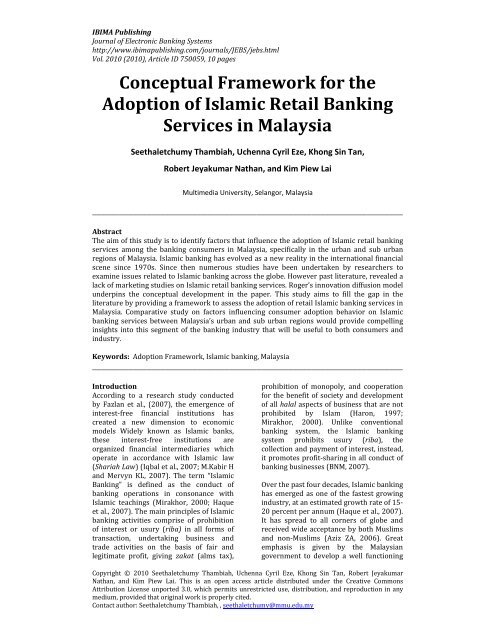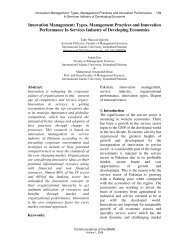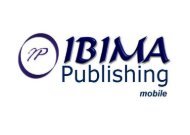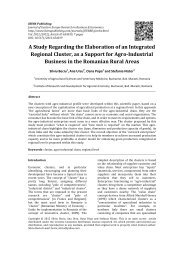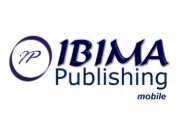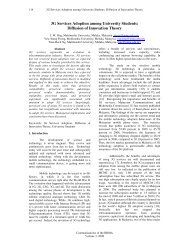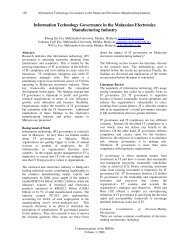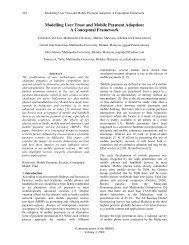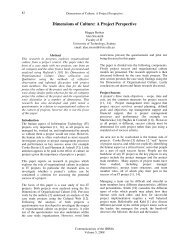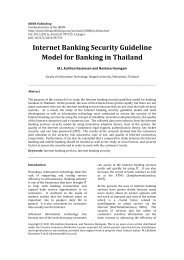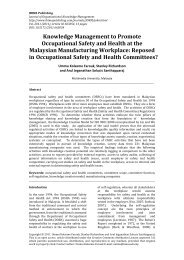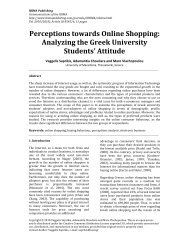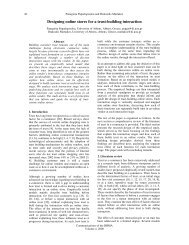Conceptual Framework for the Adoption of ... - IBIMA Publishing
Conceptual Framework for the Adoption of ... - IBIMA Publishing
Conceptual Framework for the Adoption of ... - IBIMA Publishing
Create successful ePaper yourself
Turn your PDF publications into a flip-book with our unique Google optimized e-Paper software.
<strong>IBIMA</strong> <strong>Publishing</strong><br />
Journal <strong>of</strong> Electronic Banking Systems<br />
http://www.ibimapublishing.com/journals/JEBS/jebs.html<br />
Vol. 2010 (2010), Article ID 750059, 10 pages<br />
<strong>Conceptual</strong> <strong>Framework</strong> <strong>for</strong> <strong>the</strong><br />
<strong>Adoption</strong> <strong>of</strong> Islamic Retail Banking<br />
Services in Malaysia<br />
Seethaletchumy Thambiah, Uchenna Cyril Eze, Khong Sin Tan,<br />
Robert Jeyakumar Nathan, and Kim Piew Lai<br />
Multimedia University, Selangor, Malaysia<br />
____________________________________________________________________<br />
Abstract<br />
The aim <strong>of</strong> this study is to identify factors that influence <strong>the</strong> adoption <strong>of</strong> Islamic retail banking<br />
services among <strong>the</strong> banking consumers in Malaysia, specifically in <strong>the</strong> urban and sub urban<br />
regions <strong>of</strong> Malaysia. Islamic banking has evolved as a new reality in <strong>the</strong> international financial<br />
scene since 1970s. Since <strong>the</strong>n numerous studies have been undertaken by researchers to<br />
examine issues related to Islamic banking across <strong>the</strong> globe. However past literature, revealed a<br />
lack <strong>of</strong> marketing studies on Islamic retail banking services. Roger’s innovation diffusion model<br />
underpins <strong>the</strong> conceptual development in <strong>the</strong> paper. This study aims to fill <strong>the</strong> gap in <strong>the</strong><br />
literature by providing a framework to assess <strong>the</strong> adoption <strong>of</strong> retail Islamic banking services in<br />
Malaysia. Comparative study on factors influencing consumer adoption behavior on Islamic<br />
banking services between Malaysia’s urban and sub urban regions would provide compelling<br />
insights into this segment <strong>of</strong> <strong>the</strong> banking industry that will be useful to both consumers and<br />
industry.<br />
Keywords: <strong>Adoption</strong> <strong>Framework</strong>, Islamic banking, Malaysia<br />
____________________________________________________________________<br />
Introduction<br />
According to a research study conducted<br />
by Fazlan et al., (2007), <strong>the</strong> emergence <strong>of</strong><br />
interest-free financial institutions has<br />
created a new dimension to economic<br />
models Widely known as Islamic banks,<br />
<strong>the</strong>se interest-free institutions are<br />
organized financial intermediaries which<br />
operate in accordance with Islamic law<br />
(Shariah Law) (Iqbal et al., 2007; M.Kabir H<br />
and Mervyn KL, 2007). The term “Islamic<br />
Banking” is defined as <strong>the</strong> conduct <strong>of</strong><br />
banking operations in consonance with<br />
Islamic teachings (Mirakhor, 2000; Haque<br />
et al., 2007). The main principles <strong>of</strong> Islamic<br />
banking activities comprise <strong>of</strong> prohibition<br />
<strong>of</strong> interest or usury (riba) in all <strong>for</strong>ms <strong>of</strong><br />
transaction, undertaking business and<br />
trade activities on <strong>the</strong> basis <strong>of</strong> fair and<br />
legitimate pr<strong>of</strong>it, giving zakat (alms tax),<br />
prohibition <strong>of</strong> monopoly, and cooperation<br />
<strong>for</strong> <strong>the</strong> benefit <strong>of</strong> society and development<br />
<strong>of</strong> all halal aspects <strong>of</strong> business that are not<br />
prohibited by Islam (Haron, 1997;<br />
Mirakhor, 2000). Unlike conventional<br />
banking system, <strong>the</strong> Islamic banking<br />
system prohibits usury (riba), <strong>the</strong><br />
collection and payment <strong>of</strong> interest, instead,<br />
it promotes pr<strong>of</strong>it-sharing in all conduct <strong>of</strong><br />
banking businesses (BNM, 2007).<br />
Over <strong>the</strong> past four decades, Islamic banking<br />
has emerged as one <strong>of</strong> <strong>the</strong> fastest growing<br />
industry, at an estimated growth rate <strong>of</strong> 15-<br />
20 percent per annum (Haque et al., 2007).<br />
It has spread to all corners <strong>of</strong> globe and<br />
received wide acceptance by both Muslims<br />
and non-Muslims (Aziz ZA, 2006). Great<br />
emphasis is given by <strong>the</strong> Malaysian<br />
government to develop a well functioning<br />
Copyright © 2010 Seethaletchumy Thambiah, Uchenna Cyril Eze, Khong Sin Tan, Robert Jeyakumar<br />
Nathan, and Kim Piew Lai. This is an open access article distributed under <strong>the</strong> Creative Commons<br />
Attribution License unported 3.0, which permits unrestricted use, distribution, and reproduction in any<br />
medium, provided that original work is properly cited.<br />
Contact author: Seethaletchumy Thambiah, , seethaletchumy@mmu.edu.my
Journal <strong>of</strong> Electronic Banking Systems 2<br />
and efficient Islamic banking system. It is<br />
not a coincidence that Islamic banking is<br />
making its progress in Malaysia but it is <strong>the</strong><br />
Malaysian government’s vision to develop a<br />
progressive and robust Islamic banking<br />
industry, rooted in <strong>the</strong> Islamic core values<br />
and principles that best serve <strong>the</strong> needs <strong>of</strong><br />
<strong>the</strong> nation’s economy. It is <strong>the</strong> aspiration <strong>of</strong><br />
<strong>the</strong> Malaysian government to have a strong<br />
Islamic banking industry capturing 20<br />
percent <strong>of</strong> <strong>the</strong> market share <strong>of</strong> financing<br />
and deposits in <strong>the</strong> Malaysian financial<br />
industry by 2010 (Aziz ZA, 2007).<br />
Background <strong>of</strong> Islamic Banking in<br />
Malaysia<br />
While <strong>the</strong> opportunities <strong>for</strong> Islamic banking<br />
will continue to grow <strong>the</strong>re is a need to<br />
develop products and services that are in<br />
line with <strong>the</strong> changing needs and demands<br />
<strong>of</strong> customers to remain competitive in <strong>the</strong><br />
business. Generally fiercer level <strong>of</strong><br />
competition in <strong>the</strong> banking sector has<br />
intensified over <strong>the</strong> past few years not only<br />
in Malaysia but globally. The process <strong>of</strong><br />
globalization and liberalization toge<strong>the</strong>r<br />
with digitalization has fueled <strong>the</strong> intensity<br />
<strong>of</strong> business competition today. Islamic<br />
banking in Malaysia, as one <strong>of</strong> <strong>the</strong> most<br />
important players in <strong>the</strong> service industry is<br />
faced with stiff competition, not only with<br />
<strong>the</strong> long established conventional banking<br />
system and <strong>the</strong> international players but<br />
also within <strong>the</strong>mselves.<br />
As competition intensifies and as one <strong>of</strong> <strong>the</strong><br />
most important players in <strong>the</strong> service<br />
industry today, Islamic banking is no<br />
longer regarded as a business entity<br />
striving to fulfill only <strong>the</strong> religious<br />
obligations <strong>of</strong> <strong>the</strong> Muslim community, but<br />
more significantly as a business that ought<br />
to be as competitive as conventional<br />
banking. This necessitates Islamic financial<br />
institutions to really understand <strong>the</strong> needs<br />
<strong>of</strong> <strong>the</strong>ir customers towards Islamic banking<br />
services. In Malaysia, customers’ positive<br />
perception towards Islamic banking is far<br />
more crucial mainly due to <strong>the</strong> fact that<br />
Islamic banks have to compete with <strong>the</strong><br />
dominant and long established<br />
conventional banks in a dual-banking<br />
system, since 1983 (Asyraf, 2007).<br />
In <strong>the</strong> context <strong>of</strong> Malaysia it has been more<br />
than two decades now, ever since Islamic<br />
banking was launched in Malaysia, way<br />
back in 1983, when Bank Islam Malaysia<br />
Berhad (BIMB) first commenced its<br />
operations (BNM, 2005). And it is <strong>the</strong><br />
aspiration <strong>of</strong> <strong>the</strong> Malaysian government to<br />
have a strong Islamic banking industry<br />
capturing 20 percent <strong>of</strong> market share <strong>of</strong><br />
financing and deposits in <strong>the</strong> Malaysian<br />
financial industry by 2010 (Aziz ZA, 2005).<br />
However, <strong>the</strong> market share <strong>of</strong> Islamic<br />
assets, deposits and financing as <strong>of</strong> year<br />
2008, stood at only 15.4 percent, 14.02<br />
percent and 13.96 percent <strong>of</strong> <strong>the</strong> industry’s<br />
total, despite being in operation <strong>for</strong> <strong>the</strong><br />
past twenty five years (BNM, 2008).<br />
Undoubtedly, it is a growing market but <strong>the</strong><br />
growth is slow compared to some<br />
countries like Bahrain and Bangladesh<br />
which already have exceeded 20 percent <strong>of</strong><br />
market share in terms <strong>of</strong> assets, deposits<br />
and financing.<br />
Moreover, Bahrain and Bangladesh also<br />
practice a dual banking system like<br />
Malaysia where, Islamic and conventional<br />
banking co-exist, but <strong>the</strong>se countries have<br />
successfully captured substantial market<br />
share compared to Malaysia. Bahrain which<br />
entered into Islamic banking system in<br />
1978 (Bahrain Islamic Bank), has emerged<br />
into a leading Global Islamic financial<br />
centre in <strong>the</strong> Middle East within two<br />
decades <strong>of</strong> its existence (BMA, 2007).<br />
Today Bahrain has <strong>the</strong> highest<br />
concentration <strong>of</strong> Islamic financial<br />
institutions than any o<strong>the</strong>r country. There<br />
are 187 banks operating in Bahrain <strong>of</strong><br />
which 24 are Islamic banks and it has<br />
successfully captured, market share <strong>of</strong> 32<br />
percent in terms <strong>of</strong> assets, 29 percent in<br />
terms <strong>of</strong> financing and 37 percent <strong>of</strong><br />
deposits, respectively (BMA, 2007).<br />
Despite that, in <strong>the</strong> Asian region, <strong>the</strong><br />
growth <strong>of</strong> Islamic banking in Bangladesh<br />
which entered into Islamic banking system<br />
in 1983 (Islami Bank <strong>of</strong> Bangladesh), same<br />
time with Malaysia, is extremely<br />
remarkable (CBA, 2007). As <strong>of</strong> 2007, <strong>the</strong><br />
Islamic banking in Bangladesh has<br />
captured market share <strong>of</strong> 29 percent, 30<br />
percent and 28.5 percent in terms <strong>of</strong>
3 Journal <strong>of</strong> Electronic Banking Systems<br />
Islamic assets, financing and deposits<br />
respectively (CBA, 2007).<br />
There<strong>for</strong>e in <strong>the</strong> context <strong>of</strong> Malaysia,<br />
although <strong>the</strong> number <strong>of</strong> Malaysian banking<br />
consumers using Islamic banking products<br />
and services are growing, obviously a<br />
majority still have not adopted <strong>the</strong> system.<br />
The system has not fully reached or<br />
diffused all levels <strong>of</strong> community like <strong>the</strong><br />
matured market <strong>of</strong> conventional banking. A<br />
successful system is one that has been well<br />
exposed and at <strong>the</strong> same time well<br />
accepted and extensively used by <strong>the</strong><br />
people (Aziz, ZA, 2007). In this regard, <strong>the</strong><br />
ability <strong>of</strong> <strong>the</strong> Islamic banking industry to<br />
capture a significant market share that is<br />
20 percent by 2010, in a rapidly evolving<br />
and competitive financial environment, is a<br />
challenge.<br />
Despite that, although Islamic banks have<br />
been able to grow quickly, <strong>the</strong>ir growth has<br />
been constrained by lack <strong>of</strong> innovation (<br />
Mirakhor, 2000; Asyraf et al., 2007; Bobat,<br />
2007). Whereas, innovation is <strong>the</strong> key to<br />
sustainable and competitive marketing<br />
advantage which, will ensure <strong>the</strong> future<br />
growth <strong>of</strong> Islamic financial markets.<br />
According to Bobat (2007), developing new<br />
Islamic financial products in compliance<br />
with <strong>the</strong> Shari’ah is challenging. There<strong>for</strong>e,<br />
Failure to provide <strong>the</strong> full range and <strong>the</strong><br />
right quality <strong>of</strong> products as per <strong>the</strong> need <strong>of</strong><br />
<strong>the</strong> customers may defeat <strong>the</strong> very purpose<br />
behind Islamic banks’ existence and to stay<br />
competitive in <strong>the</strong> industry.<br />
Thus, developing innovative products and<br />
widening <strong>the</strong> product range calls <strong>for</strong><br />
substantial and continuous research in this<br />
area because understanding customer<br />
needs is <strong>the</strong> key factor that determines <strong>the</strong><br />
consumer demand and successful<br />
marketing <strong>of</strong> a product or service (Mettawa<br />
SA and Almossawi M, 1998; Naser et al.,<br />
1999). Moreover, success in marketing<br />
relies on in<strong>for</strong>mation about complete and<br />
up-to-date consumer pr<strong>of</strong>iles. Fur<strong>the</strong>rmore<br />
Islamic banking in Malaysia is still at its<br />
developing stage and <strong>the</strong>re are tremendous<br />
growth opportunities as it is increasingly<br />
gaining prominence in <strong>the</strong> region and, as it<br />
has <strong>the</strong> potential to be <strong>the</strong> regional hub <strong>of</strong><br />
Islamic finance. The growth in market<br />
share <strong>for</strong> Islamic banking assets, financing<br />
and deposits (2003-2008) is illustrated in<br />
Appendix 1. There<strong>for</strong>e, it is imperative to<br />
conduct continuous research and<br />
periodical surveys in this area to clearly<br />
understand <strong>the</strong> changing needs and <strong>the</strong><br />
benefits sought by consumers, which will<br />
definitely help <strong>the</strong> financial institutions to<br />
make plausible and effective marketing<br />
decisions regarding Islamic banking<br />
products.<br />
Un<strong>for</strong>tunately <strong>the</strong> marketing aspects <strong>of</strong><br />
Islamic banking in Malaysia, although<br />
important, received little attention from<br />
<strong>the</strong> scholars especially after <strong>the</strong> year 1999<br />
(Ahmad et al., 2002; Abbas et al., 2003;<br />
Asyraf et al., 2007). Fur<strong>the</strong>rmore, previous<br />
marketing studies in Malaysia are limited<br />
in scope and representation, where <strong>the</strong><br />
main focus was consumers <strong>of</strong> urban<br />
regions and very limited studies were<br />
represented by consumers from suburban<br />
and rural regions (Abbas et al., 2003;<br />
Haque et al., 2007; Asyraf et al., 2007;<br />
Fazlan et al., 2007). Besides that, most <strong>of</strong><br />
<strong>the</strong> previous Islamic banking adoption<br />
studies in Malaysia were represented by<br />
Muslim consumers (Kader et al., 1995;<br />
Naser et al., 1999; Ahmad et al., 2002)and<br />
only limited studies have included non-<br />
Muslims as respondents (Haque et al.,<br />
2007; Asyraf et al., 2007).<br />
Malaysia cannot remain unaware <strong>of</strong> <strong>the</strong><br />
new competition growing in neighboring<br />
Singapore and Thailand. Singapore is an<br />
important economy in <strong>the</strong> South-East Asian<br />
region, where new initiatives are aimed, in<br />
developing Islamic asset management.<br />
Local financial institutions are warned, that<br />
without fur<strong>the</strong>r growth and consolidation<br />
<strong>of</strong> this industry <strong>the</strong>re is a possibility that<br />
Singapore will position itself to eventually<br />
become <strong>the</strong> lead player in South-East Asia<br />
(Bobat, 2007).<br />
In this environment, <strong>for</strong> <strong>the</strong> Malaysian<br />
Islamic financial institutions to <strong>for</strong>mulate<br />
and implement successful marketing<br />
strategies is a challenge again. This is<br />
because <strong>the</strong> key ingredient here is a clear<br />
understanding <strong>of</strong> <strong>the</strong> behavior, attitudes<br />
and perceptions <strong>of</strong> <strong>the</strong>ir banking<br />
consumers (Bobat, 2007).
Journal <strong>of</strong> Electronic Banking Systems 4<br />
Research Objectives<br />
The objective <strong>of</strong> this study is to understand<br />
<strong>the</strong> nature <strong>of</strong> consumer adoption <strong>of</strong> Islamic<br />
banking, in particular retail banking<br />
services, in urban and sub-urban regions <strong>of</strong><br />
Malaysia. Specifically <strong>the</strong> objectives are<br />
spelled out as below:<br />
• To determine <strong>the</strong> factors that affect,<br />
Islamic banking adoption in<br />
Malaysia.<br />
• To compare <strong>the</strong> similarities and<br />
differences <strong>of</strong> factors that affect<br />
Islamic banking services adoption<br />
between <strong>the</strong> urban and sub-urban<br />
regions <strong>of</strong> Malaysia.<br />
• To analyze <strong>the</strong> perception and<br />
preference <strong>of</strong> banking consumers in<br />
regard to Islamic banking services in<br />
<strong>the</strong> urban and suburban regions <strong>of</strong><br />
Malaysia.<br />
Theory Building<br />
While numerous studies have been<br />
undertaken to examine issues in <strong>the</strong> wider<br />
context <strong>of</strong> Islamic banking system,<br />
comprehensive and continuous research in<br />
<strong>the</strong> area <strong>of</strong> marketing particularly,<br />
consumer adoption <strong>of</strong> Islamic banking<br />
services in <strong>the</strong> specific context <strong>of</strong> Malaysia<br />
has been ra<strong>the</strong>r limited. This study aims to<br />
address <strong>the</strong> question about factors<br />
affecting Islamic banking adoption not only<br />
in <strong>the</strong> urban regions <strong>of</strong> Malaysia but most<br />
importantly <strong>the</strong> sub-urban regions <strong>of</strong><br />
Malaysia as well. It is crucial to gain a<br />
thorough understanding <strong>of</strong> <strong>the</strong><br />
differentiated needs and preferences <strong>of</strong><br />
customers between <strong>the</strong>se two regions, so<br />
that appropriate marketing strategies can<br />
be <strong>for</strong>mulated to capture <strong>the</strong> market,<br />
instead <strong>of</strong> having a uni<strong>for</strong>m marketing<br />
strategy <strong>for</strong> all <strong>the</strong> segments across<br />
(Ahmad et al., 2002; Abbas et al., 2003;<br />
Asyraf et al., 2007 ).<br />
In addition, <strong>the</strong> traditional focus <strong>of</strong><br />
adoption research, always has been on new<br />
product innovations and very small but<br />
growing number <strong>of</strong> studies have been<br />
conducted on <strong>the</strong> adoption <strong>of</strong> financial<br />
services (Sathye et al., 1999; Meuter et al.,<br />
1999; Black et al., 2001; Gerard, 2003).One<br />
exception being Yus<strong>of</strong> (1999), whose <strong>the</strong>sis<br />
examined <strong>the</strong> adoption <strong>of</strong> Islamic banking<br />
in Singapore. Moreover, <strong>the</strong> marketing<br />
aspect <strong>of</strong> Islamic banking, though<br />
important, received little attention from<br />
<strong>the</strong> scholars (Naser et al., 1999; Almossawi,<br />
M 2001; Ahmad et al., 2002; Asyraf et al.,<br />
2007). This is obvious from <strong>the</strong> literature<br />
review, after <strong>the</strong> year 1999; <strong>the</strong>re have<br />
been very few studies on <strong>the</strong> marketing<br />
aspect <strong>of</strong> Islamic banking, especially in<br />
Malaysia where Islamic banking is still at<br />
developing stage.<br />
Apart from <strong>the</strong> above, in <strong>the</strong> context <strong>of</strong><br />
Malaysia, <strong>the</strong> previous studies related to<br />
Islamic banking adoption is limited in<br />
scope ei<strong>the</strong>r due to limited sample size or<br />
restrictive in representation (Asyraf et al.,<br />
2007). As opined by Asyraf and<br />
Nurdianawati (2007), research by Ahmad<br />
and Haron (2002), <strong>for</strong> instance was<br />
represented by only 45 respondents. As <strong>for</strong><br />
Kader (1993, 1995) and Haron et al, 1994),<br />
<strong>the</strong>ir samples were restrictive in <strong>the</strong> sense<br />
that <strong>the</strong>y were collected from one single<br />
location or district. Kader’s study (1993,<br />
1995), <strong>the</strong> survey was confined to one<br />
location, that is, Kuala Lumpur. Similarly<br />
<strong>for</strong> <strong>the</strong> studies conducted by Haron et al.,<br />
(1994), <strong>the</strong> samples were drawn from<br />
three towns namely: Alor Setar, Sungai<br />
Petani and Kangar. Whilst, Asyraf and<br />
Nurdianawati (2007) in <strong>the</strong>ir research<br />
have included only <strong>the</strong> major cities <strong>of</strong><br />
Malaysia, that is, Kelantan, Penang, Kuala<br />
Lumpur and Johore and did not cover any<br />
towns from <strong>the</strong> sub-urban regions and<br />
rural regions <strong>of</strong> Malaysia. These ef<strong>for</strong>ts<br />
could be inadequate to represent <strong>the</strong><br />
overall needs and demand <strong>of</strong> <strong>the</strong> banking<br />
consumers in Malaysia. There<strong>for</strong>e, samples<br />
to conduct a comparative analysis <strong>for</strong> this<br />
study will be drawn from <strong>the</strong> major cities<br />
and towns classified as minor settlement<br />
regions (suburban) <strong>of</strong> Malaysia, in order to<br />
cover wider scope <strong>of</strong> representation.<br />
CONCEPTUAL FRAMEWORK<br />
Diffusion <strong>of</strong> Innovation Theory (DOI)<br />
One <strong>of</strong> <strong>the</strong> widely used models in <strong>the</strong> area<br />
<strong>of</strong> innovation adoption is Rogers’ “Diffusion<br />
<strong>of</strong> Innovation” <strong>the</strong>ory (Rogers E.M, 1999,<br />
2003). The scholarly work <strong>of</strong> Roger (1962)<br />
has encouraged research studies in <strong>the</strong>
5 Journal <strong>of</strong> Electronic Banking Systems<br />
area <strong>of</strong> diffusion and adoption extensively<br />
(Rogers, 1999, 2003). Approximately 5,200<br />
diffusion studies had been identified by<br />
Rogers (2003) while working on <strong>the</strong> 5 th<br />
edition <strong>of</strong> his text. In general, <strong>the</strong> adoption<br />
process has been defined as <strong>the</strong> process<br />
through which individual adopters pass<br />
from awareness to full acceptance <strong>of</strong> a new<br />
innovation (Rogers E.M, 1999; 2003).<br />
According to Roger <strong>the</strong>re are two levels to<br />
adoption. Initially, innovation must be<br />
purchased, acquired and adopted by<br />
individuals or organizations. Subsequently,<br />
it must be ei<strong>the</strong>r accepted or rejected by<br />
<strong>the</strong> ultimate users in <strong>the</strong> society or<br />
community. The relative newness <strong>of</strong> <strong>the</strong>se<br />
innovations and <strong>the</strong> associated uncertainty<br />
is what differentiates innovation adoption<br />
decisions from o<strong>the</strong>r types <strong>of</strong> decision<br />
making (Gerard et al., 2003).<br />
However getting a new idea adopted, even<br />
it has obvious advantages, is difficult. Many<br />
innovations require a lengthy period <strong>of</strong><br />
many years, from <strong>the</strong> time when <strong>the</strong>y<br />
become available, to <strong>the</strong> time when <strong>the</strong>y<br />
are widely adopted. Fur<strong>the</strong>rmore <strong>the</strong> same<br />
innovation may be desirable <strong>for</strong> one<br />
situation but undesirable <strong>for</strong> ano<strong>the</strong>r<br />
potential adopter, whose situation differs<br />
(Erol et al., 1989; Erol et al., 1990; Gerard<br />
et al., 2003). Rogers (2003) identified five<br />
main characteristics <strong>of</strong> innovations:<br />
Relative advantage, compatibility,<br />
complexity, observability and trialability as<br />
<strong>the</strong> most important explanation <strong>of</strong> <strong>the</strong> rate<br />
<strong>of</strong> innovation adoption (Yus<strong>of</strong>, 1999; Sohail<br />
et al., 2002; Rogers, 2003). Most <strong>of</strong> <strong>the</strong><br />
variance in <strong>the</strong> rate <strong>of</strong> adoption <strong>of</strong><br />
innovations, from 49 to 87 percent is<br />
explained by <strong>the</strong>se attributes (Rogers,<br />
2003). Thus, <strong>the</strong> diffusion literature<br />
provides an ideal framework to be applied<br />
to <strong>the</strong> present study which, seeks to extend<br />
<strong>the</strong> research area in a service innovation<br />
context, <strong>the</strong> innovation being Islamic<br />
banking. The study would determine which<br />
factors according to Rogers’ framework<br />
(2003), would fare when applied on a<br />
service innovation, more particularly retail<br />
banking services which con<strong>for</strong>m to Islamic<br />
principles.<br />
There<strong>for</strong>e <strong>the</strong> dependent and independent<br />
variable <strong>of</strong> primary interest to this<br />
research is derived from <strong>the</strong> <strong>the</strong>ory <strong>of</strong><br />
Diffusion <strong>of</strong> Innovation model (Rogers,<br />
2003).<br />
Research Variables<br />
Islamic banking adoption being <strong>the</strong><br />
dependent variable, <strong>the</strong> independent<br />
variables include: Consumer Awareness,<br />
Relative Advantage, Compatibility,<br />
Complexity, Trialability, Observability and<br />
Uncertainty.<br />
Consumer Awareness<br />
<strong>Adoption</strong> is <strong>the</strong> acceptance and continued<br />
use <strong>of</strong> a product, service or idea. According<br />
to Rogers (2003), consumers go through a<br />
process <strong>of</strong> knowledge, persuasion, decision<br />
and confirmation be<strong>for</strong>e <strong>the</strong>y are ready to<br />
adopt a product or service. Knowledge<br />
occurs when an individual or o<strong>the</strong>r<br />
decision-making unit is exposed to an<br />
innovation’s existence and gains an<br />
understanding <strong>of</strong> how it functions (Rogers,<br />
2003). He has quoted this as <strong>the</strong> “Precontemplation”<br />
stage. Consumer<br />
awareness have been tested as one <strong>of</strong> <strong>the</strong><br />
key variable in numerous studies<br />
specifically in <strong>the</strong> area <strong>of</strong> on-line banking,<br />
internet-banking and self- services<br />
technology adoption (Sathye, 1999;<br />
Suganthi et al., 1999; Yus<strong>of</strong>, 1999; Gerad et<br />
al., 2003).<br />
However, limited studies have investigated<br />
on consumer awareness in <strong>the</strong> area <strong>of</strong><br />
Islamic banking adoption. Haron (1994), in<br />
his studies stated that about 100 percent <strong>of</strong><br />
<strong>the</strong> Muslim population and 75 percent <strong>of</strong><br />
non-Muslims are aware <strong>of</strong> <strong>the</strong> existence <strong>of</strong><br />
Islamic banking services in Malaysia and<br />
out <strong>of</strong> this only 63 percent understood <strong>the</strong><br />
difference between Islamic banks and<br />
conventional banks. Whereas, some studies<br />
reported, Muslim respondents, though<br />
aware <strong>of</strong> fundamental terms in Islam, were<br />
almost exclusively unaware <strong>of</strong> <strong>the</strong> meaning<br />
<strong>of</strong> specific Islamic financial terms like<br />
Mudaraba, Musharaka and Ijara (Gerard,<br />
1997; Kamal et al., 1999).<br />
Proposition 1:<br />
There is a positive<br />
relationship between<br />
customer awareness<br />
and <strong>the</strong> usage <strong>of</strong>
Journal <strong>of</strong> Electronic Banking Systems 6<br />
Islamic banking<br />
services in Malaysia.<br />
Perceived Relative Advantage<br />
Relative advantage is defined as <strong>the</strong> degree<br />
to which an innovation is perceived as<br />
being better than <strong>the</strong> ‘idea’ it supersedes<br />
(Rogers, 1999). Potential adopters want to<br />
know <strong>the</strong> degree to which a new idea is<br />
better than an existing one. According to<br />
Yus<strong>of</strong> (1999), diffusion scholars have found<br />
relative advantage to be one <strong>of</strong> <strong>the</strong> best<br />
predictors <strong>of</strong> an innovation’s rate <strong>of</strong><br />
adoption. Rogers (2003) found that<br />
adopters invariably perceived relative<br />
advantage in terms <strong>of</strong> <strong>the</strong> economic<br />
benefits and <strong>the</strong> costs resulting from <strong>the</strong><br />
adoption <strong>of</strong> an innovation and<br />
improvements that are af<strong>for</strong>ded to <strong>the</strong>ir<br />
social status. In addition to <strong>the</strong>se, economic<br />
pr<strong>of</strong>itability, low initial cost, a decrease in<br />
discom<strong>for</strong>t, social prestige, savings in time<br />
and ef<strong>for</strong>t and <strong>the</strong> immediacy <strong>of</strong> <strong>the</strong><br />
reward, have been described as <strong>the</strong> subdimensions<br />
<strong>of</strong> relative advantage (Gerard,<br />
2003). There<strong>for</strong>e, <strong>the</strong> present study intend<br />
to investigate <strong>the</strong> economic benefits<br />
(pr<strong>of</strong>its earnings, service charges and<br />
incentives) and service delivery (fast and<br />
efficient service, staff competency) <strong>of</strong><br />
Islamic banking services, within <strong>the</strong><br />
framework <strong>of</strong> relative advantage.<br />
Proposition 2: The adoption <strong>of</strong> Islamic<br />
banking by <strong>the</strong><br />
Malaysian banking<br />
consumers is positively<br />
related to <strong>the</strong> perceived<br />
relative advantage <strong>of</strong><br />
using Islamic banking<br />
services.<br />
Perceived Compatibility<br />
Compatibility is defined as <strong>the</strong> degree to<br />
which an innovation is perceived as being<br />
consistent with existing values, past<br />
experiences and <strong>the</strong> needs <strong>of</strong> potential<br />
adopters (Rogers, 2003). Thus,<br />
compatibility is a measure <strong>of</strong> <strong>the</strong> values or<br />
beliefs <strong>of</strong> consumers, <strong>the</strong> ideas <strong>the</strong>y have<br />
adopted in <strong>the</strong> past, and <strong>the</strong> ability <strong>of</strong> an<br />
innovation to meet <strong>the</strong>ir needs (Gerard,<br />
2003). As such, in regards to banking<br />
experiences and practices, <strong>the</strong> Malaysian<br />
banking consumers have already possess<br />
banking habits from <strong>the</strong> long operating<br />
conventional banks and Islamic banking<br />
functions and operations are not new to<br />
<strong>the</strong>m. There<strong>for</strong>e it is crucial to test <strong>the</strong><br />
consistency (felt need, previous banking<br />
methods) <strong>of</strong> Islamic banking services as it<br />
may have significant impact on <strong>the</strong><br />
consumers’ willingness to adopt.<br />
Proposition 3:<br />
The adoption <strong>of</strong> Islamic<br />
banking services by <strong>the</strong><br />
Malaysian banking<br />
consumers is positively<br />
related to <strong>the</strong> perceived<br />
compatibility <strong>of</strong> using<br />
Islamic banking services.<br />
Complexity<br />
Complexity is <strong>the</strong> degree to which an<br />
innovation is perceived as difficult to<br />
understand and use (Rogers, 2003).As<br />
opined by Yus<strong>of</strong> (1999) any idea could be<br />
classified on <strong>the</strong> complexity-simplicity<br />
continuum. Some innovations are clearly<br />
understood by potential adopters whereas<br />
o<strong>the</strong>rs are not. There<strong>for</strong>e, complexity has<br />
been measured in relation to perceptions<br />
about <strong>the</strong> purpose <strong>of</strong> <strong>the</strong> respective<br />
innovation, its intended use and <strong>the</strong> ease<br />
with which it can be used (Gerard, 2003). It<br />
is believed that <strong>the</strong>re is a negative<br />
relationship between complexity and<br />
adoption rate (Rogers, 2003; Gerard,<br />
2003).<br />
Proposition 4: The adoption <strong>of</strong> Islamic<br />
banking by <strong>the</strong><br />
Malaysian banking<br />
consumers is negatively<br />
related to <strong>the</strong> perceived<br />
complexity <strong>of</strong> using<br />
Islamic banking services.<br />
Trialability<br />
Trialability is “<strong>the</strong> degree to which an<br />
innovation may be experimented with on a<br />
limited basis” (Rogers, 2003). However,<br />
customers are unable to try Islamic<br />
banking services be<strong>for</strong>ehand in <strong>the</strong> same<br />
way <strong>the</strong>y can test out a hi-fi system or a car<br />
be<strong>for</strong>e purchasing. Being an intangible,<br />
Islamic banking services are, produced and
7 Journal <strong>of</strong> Electronic Banking Systems<br />
consumed at <strong>the</strong> same time. However,<br />
Islamic financial institutions should<br />
respond to this need by allowing potential<br />
users to try out <strong>the</strong>ir Islamic banking<br />
scheme. According to Rogers (2003), an<br />
innovation that is trialable can dispel<br />
uncertainty about an idea. Thus, <strong>for</strong> those<br />
who are apprehensive about <strong>the</strong> service, it<br />
may give <strong>the</strong>m <strong>the</strong> necessary confidence to<br />
use it (Gerard et al., 2003). It is believed<br />
that <strong>the</strong>re is a positive relationship<br />
between trialability and adoption rate<br />
(Gerard et al., 2003; Rogers, 2003). If an<br />
innovation can be designed so as to be tried<br />
more easily, it will have a more rapid rate<br />
<strong>of</strong> adoption (Rogers, 2003). As such it is<br />
crucial to test <strong>the</strong> trialability <strong>of</strong> Islamic<br />
banking services as it may have significant<br />
impact on <strong>the</strong> consumers’ willingness to<br />
adopt.<br />
Proposition 5: The adoption <strong>of</strong> Islamic<br />
banking by <strong>the</strong><br />
Malaysian banking<br />
consumers is positively<br />
related to <strong>the</strong> perceived<br />
trialability <strong>of</strong> using<br />
Islamic banking services.<br />
Observability<br />
Observablity is described as <strong>the</strong> degree to<br />
which <strong>the</strong> results <strong>of</strong> an innovation are<br />
visible to o<strong>the</strong>rs (Rogers, 2003). Some<br />
ideas are easily observed and<br />
communicated to o<strong>the</strong>r people, whereas<br />
o<strong>the</strong>r innovations are difficult to observe<br />
or describe to o<strong>the</strong>rs. According to Yus<strong>of</strong><br />
(1999) and Gerard (2003) this is especially<br />
true <strong>for</strong> a service where <strong>the</strong> characteristic<br />
<strong>of</strong> intangibility will hinder its visibility.<br />
Using this argument in <strong>the</strong> context <strong>of</strong><br />
Internet banking Gerard (2003),<br />
highlighted that observability does not<br />
appear to be a contributor to <strong>the</strong> adoption<br />
<strong>of</strong> Internet banking since it is most unlikely<br />
that Internet banking uses are prepared to<br />
show <strong>the</strong> results <strong>of</strong> <strong>the</strong>ir financial dealings<br />
to third parties. However Yus<strong>of</strong> (1999) in<br />
his studies, opined that in <strong>the</strong> case <strong>of</strong><br />
Islamic banking adoption, it is possible that<br />
Muslim consumers would find it easy to<br />
explain and provide evaluative feedback to<br />
o<strong>the</strong>rs regarding <strong>the</strong> benefits <strong>of</strong> using<br />
Islamic banking services, which would<br />
fur<strong>the</strong>r enhance adoption.<br />
Proposition 6: The adoption <strong>of</strong> Islamic<br />
banking by <strong>the</strong><br />
Malaysian banking<br />
consumers is positively<br />
related to <strong>the</strong> perceived<br />
observability <strong>of</strong> using<br />
Islamic banking services.<br />
Uncertainty<br />
Uncertainty is <strong>the</strong> degree to which a<br />
number <strong>of</strong> alternatives are perceived with<br />
respect to <strong>the</strong> occurrence <strong>of</strong> an event and<br />
<strong>the</strong> relative probabilities <strong>of</strong> <strong>the</strong>se<br />
alternatives (Rogers, 2003). Uncertainty<br />
motivates individuals to seek in<strong>for</strong>mation,<br />
as it is an “uncom<strong>for</strong>table state <strong>of</strong> mind”.<br />
According to Roger (2003) a kind <strong>of</strong><br />
uncertainty is generated by an innovation<br />
that is perceived as new by an individual or<br />
ano<strong>the</strong>r unit <strong>of</strong> adoption. The perceived<br />
newness <strong>of</strong> an innovation, and <strong>the</strong><br />
uncertainty associated with this newness is<br />
a distinctive aspect <strong>of</strong> innovation decision<br />
making process, that is, ei<strong>the</strong>r to adopt or<br />
reject an innovation. Thus perceived risk,<br />
trust and reliability <strong>of</strong> <strong>the</strong> system are<br />
known to be some <strong>of</strong> <strong>the</strong> attributes <strong>of</strong><br />
uncertainty (Philip.K and Armstrong, 2001;<br />
Rogers, 2003). It is believed that <strong>the</strong>re is a<br />
negative relationship between uncertainty<br />
and adoption rate (Yus<strong>of</strong>, 1999). The more<br />
consumers feel uncertain about an<br />
innovation; <strong>the</strong> lower would be <strong>the</strong> rate <strong>of</strong><br />
adoption (Rogers, 2003).<br />
Proposition 7: The adoption <strong>of</strong> Islamic<br />
banking by <strong>the</strong><br />
Malaysian banking<br />
consumers is negatively<br />
related to <strong>the</strong> perceived<br />
uncertainty <strong>of</strong> using<br />
Islamic banking services.<br />
<strong>Conceptual</strong> Model<br />
The Figure 1 below, shows <strong>the</strong> drived<br />
model from propositions. The model <strong>of</strong>fers<br />
<strong>the</strong> conceptual foundation <strong>of</strong> <strong>the</strong> research<br />
to be conducted. The conceptual model <strong>of</strong><br />
this research aims to explain, how <strong>the</strong><br />
perceived attributes <strong>of</strong> innovation<br />
determines <strong>the</strong> adoption <strong>of</strong> Islamic<br />
banking, in particular, retail banking<br />
services in Malaysia. In addition it also
Journal <strong>of</strong> Electronic Banking Systems 8<br />
aims to explain how <strong>the</strong> relationship <strong>of</strong> <strong>the</strong><br />
independent and dependent variables are<br />
modified or ra<strong>the</strong>r altered by <strong>the</strong><br />
moderating factors.<br />
Independent Variables<br />
Dependent Variable<br />
Consumer Awareness<br />
Relative Advantage<br />
Compatibility<br />
Complexity<br />
Trialability<br />
Observability<br />
Uncertainty<br />
+<br />
+<br />
-<br />
+<br />
+<br />
-<br />
+<br />
<strong>Adoption</strong> <strong>of</strong><br />
Islamic<br />
Retail Banking<br />
Services<br />
Figure 1: <strong>Conceptual</strong> Model <strong>of</strong> Islamic Retail Banking Services <strong>Adoption</strong><br />
CONCLUSION<br />
This concept paper provides a <strong>the</strong>oretical<br />
discussion on Islamic Banking<br />
development in <strong>the</strong> past and <strong>the</strong> present.<br />
Based on <strong>the</strong> extensive literature review in<br />
<strong>the</strong> areas <strong>of</strong> Banking and Islamic Banking,<br />
toge<strong>the</strong>r with <strong>the</strong> evaluation <strong>of</strong> <strong>the</strong><br />
suitability <strong>of</strong> applying Theory <strong>of</strong> Diffusion<br />
<strong>of</strong> Innovation Model, this study proposes a<br />
conceptual framework, <strong>for</strong> <strong>the</strong> study <strong>of</strong><br />
adoption <strong>of</strong> Islamic Retail Banking services<br />
by Malaysian consumers.<br />
The study fur<strong>the</strong>r recommends that <strong>the</strong><br />
conceptual model with independent and<br />
dependent variables tested <strong>for</strong><br />
relationships and to confirm <strong>the</strong> model fit<br />
upon collection <strong>of</strong> <strong>the</strong> research data. As<br />
such, <strong>the</strong> model also comprises<br />
prepositions.<br />
REFERENCES<br />
Abbas, S.Z.M., Hamid, M.A.A., Joher, H.,<br />
Ismail, S. (2003) ‘Factors That Determine<br />
Consumers' Choice in Selecting Islamic<br />
Financing Products’, paper presented at <strong>the</strong><br />
International Islamic Banking Conference,<br />
9-10th September, Prato.<br />
Ahasanul Haque, Jamil.O and Ahmad .Z<br />
(2007) ‘Islamic Banking: Customer<br />
perception and its prospect on bank<br />
product selection towards Malaysian<br />
customer perspectives’, paper presented at<br />
<strong>the</strong> Fifth International Islamic Finance<br />
Conference, 3-4 th September, Kuala<br />
Lumpur.<br />
Ahmad, N, and Haron, S (2002)<br />
‘Perceptions <strong>of</strong> Malaysian corporate<br />
customers towards Islamic banking<br />
products and services’, International
9 Journal <strong>of</strong> Electronic Banking Systems<br />
Journal <strong>of</strong> Islamic Financial Services, 3:1,<br />
13-29.<br />
Almossawi, M (2001) ‘Bank selection<br />
criteria employed by college students in<br />
Bahrain: an empirical analysis’,<br />
International Journal <strong>of</strong> Bank Marketing,<br />
19:3, 115-25.<br />
Asyraf, W, D and Nurdianawati, A (2007)<br />
‘Why do Malaysian Customers patronize<br />
Islamic Banks’, International Journal <strong>of</strong><br />
Bank Marketing, 25:3, 142-160.<br />
Aziz, ZA (2005) Building a progressive<br />
Islamic Banking sector: Charting <strong>the</strong> Way<br />
Forward, 10-Year Master Plan <strong>for</strong> Islamic<br />
Financial Services Industry, Bank Negara<br />
Malaysia, Kuala Lumpur.<br />
Aziz, ZA (2006) Islamic Banking and<br />
Finance Progress and Prospects, Collected<br />
Speeches 2000-2006, Bank Negara Malaysia,<br />
Kuala Lumpur.<br />
Aziz, ZA (2007) Governor <strong>of</strong> Central Bank<br />
<strong>of</strong> Malaysia: Keynote address at INCEIF,<br />
Inaugural Intellectual Discourse, 23<br />
February, Kuala Lumpur.<br />
Bahrain (2007) Annual Report, Bahrain<br />
Monetary Agency, Bahrain.<br />
Black, N.J., Lockett, A, Winkh<strong>of</strong>er, H. and<br />
Ennew, C (2001) ‘The adoption <strong>of</strong> internet<br />
financial services: a qualitative study’,<br />
International Journal <strong>of</strong> Retail and<br />
Distribution Management, 29:8, 390-8.<br />
Bangladesh (2007), Annual Report, Central<br />
Bank <strong>of</strong> Bangladesh, Dhaka.<br />
Bangladesh (2008), Annual Report, Central<br />
Bank <strong>of</strong> Bangladesh, Dhaka.<br />
Elvan, T and Dough, T (2004)<br />
Understanding Marketing Research,<br />
Pearson Education Publications Ltd,<br />
Australia.<br />
Erol, C and El-Bdour, R (1989) ‘Attitude,<br />
behavior and patronage factors <strong>of</strong> bank<br />
customers towards Islamic banks’,<br />
International Journal <strong>of</strong> Bank Marketing,<br />
7:6, 31-7.<br />
Erol, C, Kaynak, E and El-Bdour, R (1990)<br />
‘Conventional and Islamic bank patronage<br />
behavior <strong>of</strong> Jordanian customers’,<br />
International Journal <strong>of</strong> Bank Marketing,<br />
8:5, 25-35.<br />
Fazlan, S and Mohammad, A (2007) ‘The<br />
efficiency <strong>of</strong> Islamic Banks: Empirical<br />
Evidence from <strong>the</strong> MENA and Asian<br />
Countries Islamic Banking Sectors’, paper<br />
presented at <strong>the</strong> Fifth International Islamic<br />
Finance Conference, 3-4 th September, Kuala<br />
Lumpur.<br />
Haron, S, Ahmad, N and Planisek, SL (1994)<br />
‘Bank patronage factors <strong>of</strong> Muslim and<br />
non-Muslim customers’, International<br />
Journal <strong>of</strong> Bank Marketing, 12:1, 32-40.<br />
Haron S (1995) ‘The <strong>Framework</strong> and<br />
Concept <strong>of</strong> Islamic Interest-Free Banking’,<br />
Journal <strong>of</strong> Asian Business, 5:2, 27-36.<br />
Haron S (1997) Islamic Banking Rules and<br />
Regulations, Pelanduk Publications (M) Sdn<br />
Bhd, Kuala Lumpur.<br />
Iqbal, Z and Mirakhor, A (2007) An<br />
Introduction to Islamic Finance: Theory and<br />
Practice, John Wiley and Sons Ltd,<br />
Chichester.<br />
Kader, RA (1993), ‘Per<strong>for</strong>mance and market<br />
implications <strong>of</strong> Islamic banking: a case study<br />
<strong>of</strong> Bank Islam Malaysia Berhad’,<br />
Unpublished PhD Thesis, Durham<br />
University, Durham.<br />
Kader, RA (1995), Leading Issues in Islamic<br />
Banking and Finance, Pelanduk<br />
Publications (M) Sdn Bhd, Kuala Lumpur.<br />
Kamal Naser, Ahmat Jamal, Khalid-Al<br />
Khatib (1999) ‘Islamic Banking: A Study <strong>of</strong><br />
Customer Satisfaction and Preferences in<br />
Jordan’, International Journal <strong>of</strong> Bank<br />
Marketing, 17:13, 135-150<br />
Malaysia (2005), Annual Report, Bank<br />
Negara Malaysia, Kuala Lumpur.
Journal <strong>of</strong> Electronic Banking Systems 10<br />
Malaysia (2006), Annual Report, Bank<br />
Negara Malaysia, Kuala Lumpur.<br />
Malaysia (2007), Annual Report, Bank<br />
Negara Malaysia, Kuala Lumpur.<br />
Malaysia (2008), Annual Report, Bank<br />
Negara Malaysia, Kuala Lumpur.<br />
Mat<strong>the</strong>w Lane Meuter (1999), ‘Consumer<br />
<strong>Adoption</strong> <strong>of</strong> Innovative Self-Service<br />
Technologies: A multi-method investigation’,<br />
PhD Thesis, Arizona State University, USA.<br />
M. Kabir H. and Mervyn K. Lewis (2007),<br />
Handbook <strong>of</strong> Islamic Banking, Edward Elgar<br />
<strong>Publishing</strong> Limited, UK.<br />
Metawa, SA and Almossawi, M (1998),<br />
‘Banking behavior <strong>of</strong> Islamic bank<br />
customers: perspectives and implications’,<br />
International Journal <strong>of</strong> Bank Marketing,<br />
16:7, 299-313.<br />
Mirakhor, A (2000) ‘General Characteristics<br />
<strong>of</strong> an Islamic Economic System’, Anthology<br />
<strong>of</strong> Islamic Banking, Institute <strong>of</strong> Islamic<br />
Banking and Insurance, London, p.11-31.<br />
Naser, K, Jamal, A and Al-Khatib, L (1999)<br />
‘Islamic banking: a study <strong>of</strong> customer<br />
satisfaction and preferences in Jordan’,<br />
International Journal <strong>of</strong> Bank Marketing,<br />
17:3, 135-50.<br />
Norazah M, Suki (2006) ‘Consumer<br />
Innovation and <strong>Adoption</strong> <strong>of</strong> On-line<br />
Shopping: Malaysian Internet User’s<br />
Prospective’, PhD Thesis, Multimedia<br />
University, Malaysia.<br />
Philip Gerard and Cunningham, JB (1997)<br />
‘Islamic banking: A study in Singapore,<br />
International Journal <strong>of</strong> Bank Marketing,<br />
15:6, 204-16.<br />
Philip Gerard and Cunningham, JB (2003)<br />
‘The diffusion <strong>of</strong> Internet Banking among<br />
Singapore Consumers’, International<br />
Journal <strong>of</strong> Bank Marketing, 21:1, 16-28.<br />
Philip Kotler and Gary Armstrong (2001)<br />
Principles <strong>of</strong> Marketing (9 th edn), Prentice<br />
Hall Publication Inc, New Jersey<br />
Rogers EM (2003), Diffusion <strong>of</strong> Innovations<br />
(5 th edn), The Free Press, New York.<br />
Rogers EM (1999), Diffusion <strong>of</strong> Innovation<br />
(4 th edn), The Free Press, New York.<br />
Sadiq Sohail, M and B.Shanmugham (2002)<br />
‘E-banking and customer preferences in<br />
Malaysia: an Empirical investigation’,<br />
International Journal <strong>of</strong> In<strong>for</strong>mation<br />
Sciences (Elsevier), 15:2, 207-217.<br />
Sathye, M (1999) ‘<strong>Adoption</strong> <strong>of</strong> Internet<br />
banking by Australian consumers: an<br />
empirical investigation’, International<br />
Journal <strong>of</strong> Bank Marketing, 17:7, 324-334.<br />
Suganthi, Balachandher and Balachandran<br />
(2001) ‘Internet Banking Patronage: An<br />
Empirical Investigation <strong>of</strong> Malaysia',<br />
Journal <strong>of</strong> Internet Banking and Commerce,<br />
6:1, 15-21.<br />
Yakub Bobat (2007) ‘Islamic Banking: Need<br />
<strong>for</strong> Innovation’, paper presented at <strong>the</strong> Fifth<br />
International Islamic Finance Conference, 3-<br />
4 th September, Kuala Lumpur.<br />
Yus<strong>of</strong> MYR (1999) ‘Islamic Banking:<br />
<strong>Adoption</strong> <strong>of</strong> a Service Innovation',<br />
unpublished MSc. <strong>the</strong>sis, NTU, Singapore.


